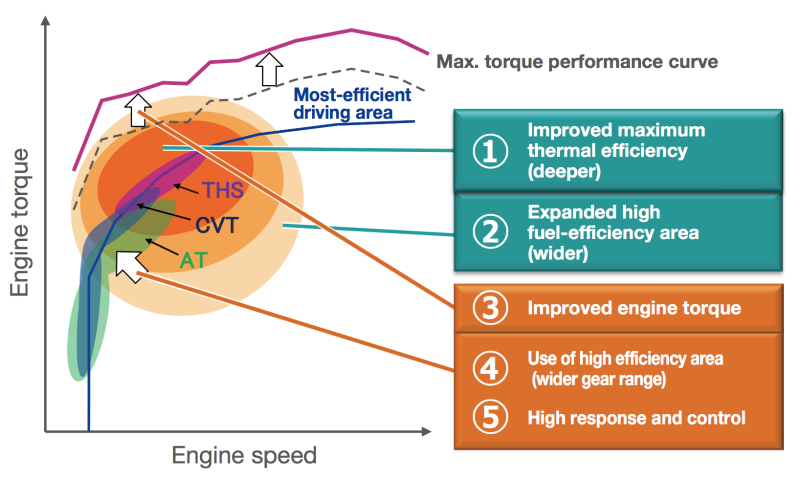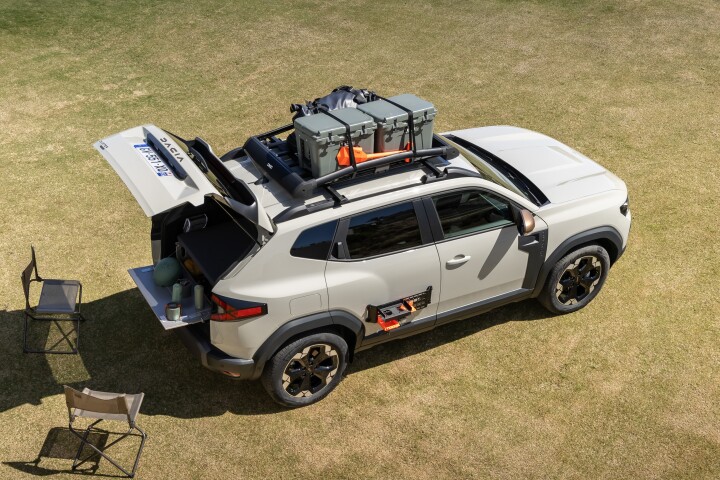Toyota has unveiled new engines based on its Toyota New Global Architecture (TNGA), to be used in both standard gasoline and hybrid vehicles. The company says that the recently-developed, more efficient engines will begin rolling out in 2017.
Toyota will introduce 17 versions of nine new engines and 10 versions of four transmissions from 2017 to 2021. These will be combined with new electrified components for 10 versions of six new hybrid-electric drive systems in that timeframe. With TNGA, Toyota is changing the car almost fundamentally, to aid every aspect of efficiency, it says. Ride height, hood angles, drivetrain weights, and more are all aspects of improving the efficiency of the automobile.
The modular design of the TNGA engines and transmissions allows for the mixture of versions that Toyota will be rolling out over the next few years. The company is targeting 10 percent better power performance (measured by vehicle 0-60 mph/0-92 km/h times) and 20 percent better fuel economy. The new TNGA engines are called "Dynamic Force Engines" and combine loss reduction (lower energy losses), improved fuel combustion, and improved air intake efficiency.
The first engine in this new architecture is a 2.5-liter four-cylinder that achieves 40 percent thermal efficiency as a gasoline-only engine, and 41 percent when used in a hybrid system. Toyota is showcasing this new engine as its illustration of TNGA. The current average for four-cylinder engine thermal efficiency is about 36.8 percent.
The 2.5L engine uses high-speed combustion and variable intake control to create strong air tumble and volume inside the cylinder. This spreads the fuel into the air to make for better combustion. The stroke-bore ratio of the engine is 1.2, balancing power outputs. The engine has a wider valve (41 degrees) which allows for better intake/exhaust. New valve seat materials and laser valve seat cladding mean lower friction losses as well.
The engine runs with a 13:1 compression ratio for gasoline-only and 14:1 for a hybrid system. High-energy ignition coils, multi-hold direct injectors, and cylinder bore and piston coatings complete the package. All of these combine to provide better thermal and friction efficiencies in the TNGA engine.
These efficiency gains result in better fuel economy and lower particulate emissions from the engine. On that latter point, Toyota is targeting 60 percent reductions.
To go with the new TNGA engines, Toyota has also developed new transmissions. A new eight-speed automatic and a new ten-speed automatic (8AT and 10AT) are being introduced. Improvements in gear tooth surfaces and clutch materials reduce friction throughout the transmissions. Clutch torque loss is reduced by approximately 50 percent, Toyota says, when compared to its conventional six-speed automatic.
The new transmissions are both lighter and more compact than those they will replace, offer a lower center of gravity, and feature a newly-developed high-performance torque converter. Toyota did not offer more information on this new unit except to say that it's smaller and more efficient than conventional torque converters.
Toyota also introduced its Toyota Hybrid System II (THS-II) as part of the TNGA rollout. These are loss-, size- and weight-reducing powertrains that also introduce the newest generation of the company's hybrid line. THS-II involves both a transverse and standard (rear-wheel drive) transmission fitted with electric motors. This hybrid system is a natural evolution of the current Hybrid Synergy Drive, involving one electric motor acting as a generator and another as a power unit for the drivetrain. A new, smaller, lighter power control unit (PCU) reduces electrical loss by about 10 percent and is mounted directly above the transaxle, making for space savings.
The motors are newly-developed and use magnetic steel and a rolling coil structure, which uses fewer wires. A parallel reduction gear reduces power transfer losses, and both the motors are smaller and lighter than before while offering similar or better power output when compared to those they'll replace. Toyota claims that when combined with the 2.5L Dynamic Force engine, this transaxle produces 20 percent better fuel economy and has acceleration improved by 10 percent.

Toyota has also enhanced the plug-in hybrid (PHV) performance through similar motor enhancements coupled with more efficient lithium-ion batteries with higher capacity, allowing for more range and higher-speed electric-only driving.
Toyota says that these improvements will begin rolling out in 2017, debuting on an as-yet-unnamed new vehicle model to be introduced soon. The new TNGA powertrain units will be featured in 60 percent of the company's lineup of vehicles by 2021. They will appear globally.
Source: Toyota











